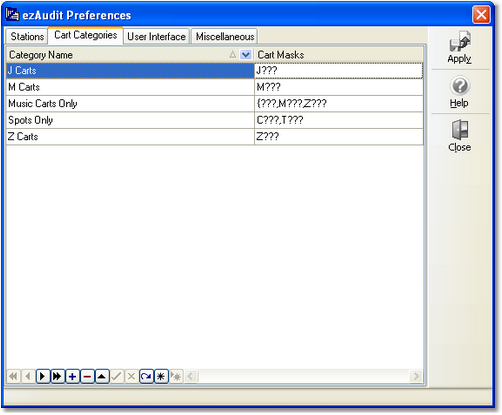ezAudit provides the ability to create "Cart Categories". A cart category is essentially a single cart number mask or group of cart number masks that can be used when displaying an XStudio, DCS, or Maestro audit report. A cart number mask is a representation of a group of cart numbers that you wish to be included in the display. You can have as many cart filter definitions as you wish, and as many cart masks per filter as you wish.
|
There must be at least one cart mask defined for each cart category you create. |
The use of a cart category will reduce the displayed cart items (audio files) to just those matching your filter definition. For instance, the sample display shows several filter definitions, including one called "Spots Only". You can see from the display that there are two cart mask associated with the Spots Only definition. One reads "C???", the other "T???". This filter definition means that, when selected, only carts beginning with the letter "C" or the letter "T" will be displayed.
The initial display of the Cart Categories page shows a table of available (defined) filters, if any, and a navigator bar which can be used to add, edit and delete cart filters.
Maintaining Cart Filters
Add a Category Name. To add a filter, click on the "+" button and type in the name you wish to use for the new category when prompted. You'll also be prompted to enter an initial cart mask. You can also use the [Insert] key on the keyboard.
|
Float your mouse over any of the controls and a description of the button or control's usage will be displayed at the bottom of the dialog. |
Edit a Category Definition Name. To edit a category name, select the name from the list, then click on the Category Name field and type your changes. Finish by clicking on the "Save Changes" (Post) button. The [F2] keystroke also invokes edit mode. The content being edited will be the column you had selected when the [F2] key was pressed. For more information data navigation buttons, see the topic Using Data Navigators.
Delete a Category Definition. To delete a cart category definition completely, select the category name and click on the "Delete" button, represented by a "-" symbol (minus sign). After confirming that you want to delete, the category definition will be removed, including associated cart masks. You can also use the [Delete] key on the keyboard.
|
Deleting a category definition also deletes all cart masks associated with the cart filter. If you didn't mean to delete the category definition, you must close the Preferences dialog and choose not to save the changes. When you re-open Preferences, the category definitions are restored to their last saved state. Be aware that not saving changes on exiting the Preferences dialog saves no changes you may have made while working in the Preferences dialog. |
Editing Cart Masks. To edit a cart mask, [Double-Click] on the mask in the mask column. A dropdown panel displays, providing the means to add, edit, and delete individual cart masks.
A cart mask must be exactly 4 (four) characters in length. The mask table will not allow entries that are too short and will not accept more than 4 characters entered. For information on specific cart mask combinations that can be used, see the topic Cart Masks Explained.
When all editing for a category is complete, save your changes by clicking on the "Save Changes" (Post Edit) data navigation button, represented by a check mark.
Importing and Exporting Cart Categories
For convenience, you can import and export cart filter settings. [Right-Click] anywhere on the displayed cart categories table and select either Import Cart Categories or Export Cart Categories. In either case, you are prompted for a file name to import from or export to.
|
When importing cart categories and some categories already exist, you have the option to either add (append) the imported categories to the existing list or replace the existing categories with the imported categories. |



